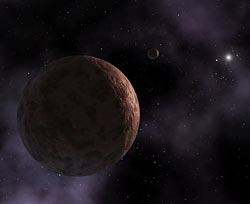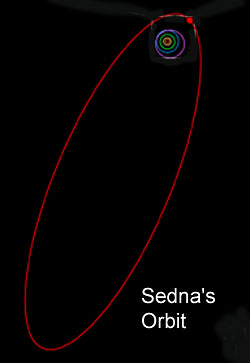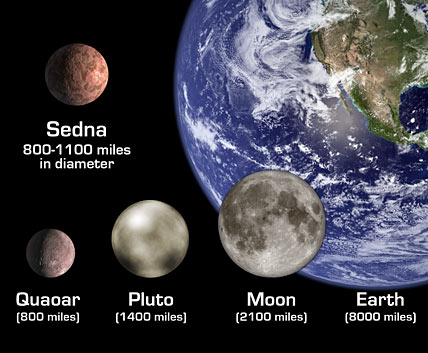
An artist's conception of the large object, informally named Sedna, discovered last year at more than twice Pluto's distance from the Sun.
Courtesy NASA / JPL / Caltech / R. Hurt.
Last year astronomers discovered what’s probably the biggest body found in the solar system since Pluto in 1930, and they didn’t know what to make of it. Sedna, as 2003 VB12 was informally named, is about half the size of the Moon and ranges from 75 to 985 astronomical units from the Sun in a highly elliptical orbit. Neptune, by comparison, is 30 a.u. from the Sun, Pluto averages 40 a.u., and the icy objects populating the Kuiper Belt drop off sharply after 55. (Early suggestions that Sedna might have a moon of its own proved false.)

Sedna's orbit compared to the rest of the solar system. The red dot indicates Sedna's position at discovery. The small purple circle is the orbit of Pluto.
Courtesy NASA / JPL / Caltech / R. Hurt.
So how did Sedna get way out there? It couldn’t have formed in place; the Sun’s protoplanetary disk was too sparse that far out. Now Alessandro Morbidelli (Côte d’Azur Observatory) and Harold F. Levison (Southwest Research Institute) have analyzed various theories in detail. In a paper to appear in the November Astronomical Journal, they rule out the possibility that Sedna could have been worked into its present orbit by gravitational interactions if Neptune were once in a more eccentric orbit, or by the past existence of massive planets in the Kuiper Belt, or by the gravitation of a massive belt itself.
The likeliest proposal, they find, is that Sedna was lifted into its present orbit by a star passing a few hundred a.u. from the solar system within 100 million years of the solar system’s birth, before the Kuiper Belt and Oort Cloud took shape. Such a close, well-timed brush would be plausible if the Sun, as seems likely, formed in a star cluster that’s now long since dispersed (see the upcoming October Sky & Telescope, page 24).
The same process could account for the similar but less extreme orbit of another far-out drifter, 2000 CR105, which ranges from 45 to 415 a.u. from the Sun.
An alternative theory, the astronomers say, is that Sedna is a true alien planet, tugged away from the outer disk of a low-mass star or brown dwarf that passed within a few hundred a.u. of the young Sun. The same flyby, they speculate, could have pulled 2000 CR105 up into its present orbit while dropping off Sedna as a permanent immigrant into the solar system. Either star-encounter scenario implies that many more such objects await discovery.

The estimated size of Sedna compared to Earth, the Moon, Pluto, and Quaoar. The latter two are especially large objects in the Kuiper Belt.
Courtesy NASA / JPL / Caltech / J/ Hurt.
 0
0
Comments
You must be logged in to post a comment.